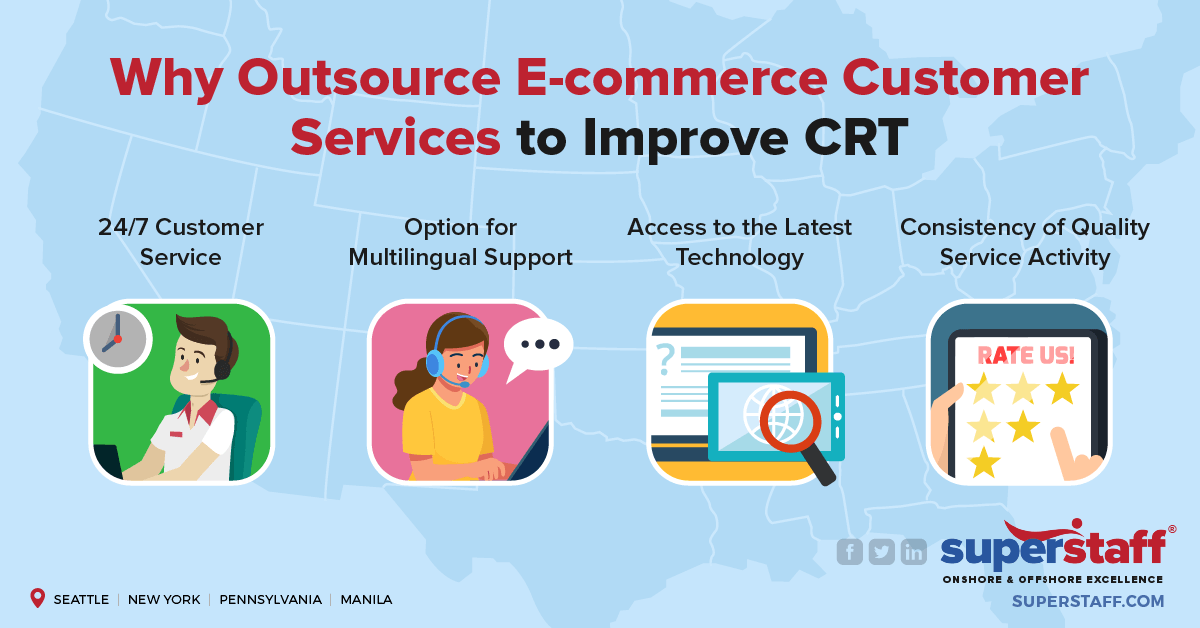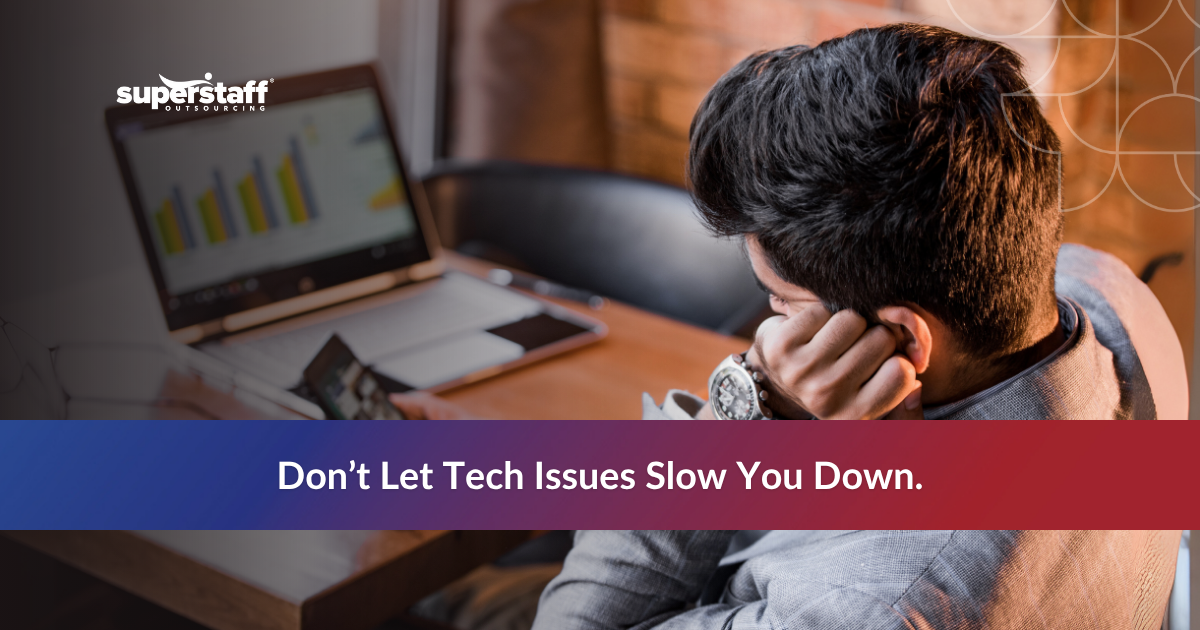
Consumers today have more options than ever. In this increasingly competitive e-commerce space, a single slip-up could send customers straight into the shopping cart of your biggest rival. In fact, according to Microsoft, 58% of consumers switch companies due to poor customer service!
To avoid any customer service blunders that could hurt your business in the long run, you must continually measure and analyze key performance indicators such as customer response times. And partnering with an e-commerce outsourcing company can be of great help with this situation.
This article will discuss what CRT is and why it’s such an essential metric for customer service. Then, we’ll cover ways to improve your CRT per channel and how e-commerce outsourcing can be your best bet at enhancing your overall customer experience!
Why Is Customer Response Time Important (and How Does E-Commerce Outsourcing Help)?
Customer response time or CRT is a crucial performance indicator defined as the time (number of minutes, hours, or days) elapsed between a user’s query or concern and the support team’s reply. It also measures how long it took to resolve the issue. This KPI is necessary for the following reasons:
Improves Customer Satisfaction
According to a Zendesk study, 60% of customers say that being put on hold and asked to wait for a long time is one of the most frustrating parts of the customer support process. When consumers are made to wait too long for a response from your customer service team, they may get impatient and stop doing business with you.
Research from Hubspot confirms these findings, noting that 90% of customers value an “immediate” response whenever they reach out to a customer service representative. One way to improve your CTR and customer satisfaction ratings is by partnering with an e-commerce customer service outsourcing company.
An e-commerce outsourcing team will ensure 24/7 coverage, working round-the-clock to give your customers the help and support they need. By simply outsourcing your customer service team, you can rest assured that your clients won’t have to wait long for an available agent to answer their questions!
Increases Customer Acquisition and Retention
Excellent customer service helps you keep customers happy, while poor service drives them away. Research has found that 67% of customer churn can be avoided when businesses resolve customer concerns within the first contact. This data proves that CTR, or how quickly you can find a solution for your buyers’ problems, has a significant impact on customer retention.
Thankfully, you can ensure quick and efficient customer response times by working with an experienced e-commerce outsourcing team. A reliable provider of customer support outsourcing will have highly trained and capable agents who know how to handle a variety of customer concerns and complaints. Your business can acquire and retain customers more efficiently with faster response times, growing their lifetime value over time.
Enhances Your Brand’s Global Reach
Unlike traditional brick-and-mortar stores, online businesses are not restricted by geography or time zones. No matter where you are in the world, customers will be able to reach you.
Imagine, however, that a potential buyer from a different country messages your business at an inconvenient hour in your time zone. Do you have a customer support team that can respond quickly and efficiently, no matter the time of day?
If the above scenario worries you, partnering with an e-commerce outsourcing firm may be your best path forward. This way, you can focus on your core business while knowing that a reliable customer service team is handling your customers’ needs, wherever they are located, whenever they decide to contact you.
How to Improve Your CRT Per Channel (With Help From E-Commerce Customer Service Outsourcing Providers)
Phone
Phone support has the highest customer satisfaction ratings (91%) among different customer service platforms. It is also the channel most customers think of when they need to contact a company. So, knowing how popular phone support continues to be, how can your business improve your CRT in this channel? Here are a few suggestions:
- Stick to a consistent schedule. One of the most critical call center metrics is adherence to schedule, which measures how much of your agents’ hours are spent on calls and being available to handle customer contacts. To improve your CRT, it’s best to set an adherence to schedule target of 85% to 90%, which increases calls per hour, allowing more customers to get their concerns heard.
- Consider staffing and availability when forecasting. Although it isn’t easy to accurately predict the number of inbound calls that can come in, forecasting is necessary for maximizing resources, especially your workforce. If you underestimate the call volume and end up understaffed, this will negatively impact your CRT and leave you with frustrated customers.
Thankfully, you can avoid this situation by working with an e-commerce outsourcing company. The right outsourced team will have top-of-the-line forecasting tools and proven methods to help you optimize your staffing and resources.
- Implement self-service systems. Another way to improve your CRT is by using self-service technologies, such as Interactive Voice Response (IVR) systems, to allow customers to resolve simple transactions by themselves. Then, agents will be freed to focus on more complex issues and concerns.
If you decide to use self-service systems, be sure to provide a way for customers to leave feedback at the end. Doing so will let you know whether your users are satisfied and that the system is functioning correctly.
- Continually train and upskill your agents. One of the most effective ways to improve your CRT is hiring and retaining top talent and helping them grow in their professional lives. The right e-commerce outsourcing provider can handle this for you, helping your customer service team improve their productivity and overall performance while also making them better equipped to deal with customer problems.
- Keep up with the latest technological advances. New technologies present significant changes in the customer service industry, and businesses must keep track of the trends to maximize their customer support. These tools, including AI, self-service software, video voicemail, and more, can help improve workflow efficiency and increase customer satisfaction.
When you outsource e-commerce customer services to the right provider, they will know how to utilize these tools to benefit your business, improve your CRT by optimizing processes, and practice flexibility and adaptability in customer service.
Live Chat
Although phone support remains one of the most enduring and popular methods of reaching customer service, live chat is becoming a close contender. It is the channel with the second-highest customer satisfaction rating at 85%. In a recent survey, 51% of consumers said they are more likely to stick with a brand or buy from them again if they offer chat support.
Here are some helpful tips businesses can try to improve their CRT for live chat:
- Focus on quality. Although live chat is known for speedy responses (with the average wait time for chat support being 46 seconds!), it’s important to remember that faster isn’t always better. Improving your CRT is about how quickly you respond to a customer and how efficiently you can resolve their concerns.
Consumers don’t mind waiting a bit longer for a quality response than getting an immediate yet unhelpful reply. So, remember: value your customers’ time but don’t rush a response just for the sake of it. Working with a reliable e-commerce outsourcing team can significantly help because they know how to handle quantity and quality when resolving customer concerns.
- Sync customer conversations into one shared support inbox. For support teams, keeping tabs on multiple conversations can get overwhelming. One way to ensure that no customer queries are lost in the chaos is by using tools that streamline and integrate all customer interactions into one inbox. This way, everyone in the support team can see which unresolved conversations are being handled and which ones need urgent attention.
- Set a welcome message into your live chat app. Suppose you’re currently handling a lot of support requests or are understaffed for the day. What can you do to ensure that your CRT doesn’t suffer? One simple yet effective tip is to set up a chatbot with a welcome message to let customers know that their query has been received and that someone will get in touch with them shortly.
You can also use this welcome message as a chance to set customer expectations. For instance, you could let customers know that you are receiving many support requests and give a timeline for when you will likely get back to them.
- Display active or recently online agents. With chat support software, customers aren’t always sure if an actual person at the other end can handle their concerns. To reassure them that your e-commerce customer service outsourcing team is ready to help and respond, display active agents in your live chat app.
- Set up notifications for real-time conversations. Every time new messages come in, it’s essential that everyone on your support team is notified immediately. Create a custom view for real-time conversations on your live chat app and set it up to send notifications to your workplace messenger app. This makes it easier for your support team to see if any new customer concerns need attention.
Phone support and live chat are consumers’ most used customer service channels. However, we cannot underestimate the importance of email support. According to Microsoft, 78% of customers use email for queries and feedback regularly.
Although emails may not seem as “instant” as live chat and phone calls, CRT is still essential for this channel. Here are a few tips to help you with email support:
- Set a clear, realistic, and actionable email response goal. A research study about customer expectations found that 44% of consumers expect support teams to answer their emails beyond an hour but within 24 hours, and 21% expected an answer within an hour. Although setting a goal of answering customer emails within an hour can be done, you must also remember that complex issues can take longer to answer and resolve.
The key here is not to treat each email as the same but to set realistic time frames depending on the problem. For instance, simple and common concerns should be resolved within the hour. However, for more complex customer issues, answering within 24 hours can be the minimum reply threshold.
- Make sure your first response is helpful. When it comes to email support, the first response matters most to customers. Make sure to leave a positive lasting impression in their mind by directly addressing their concern and thus building their trust in you. Unlike calls and live chat, emails allow your support team more time to develop a quality response, so don’t rush the first reply.
- Use response templates. To improve your CRT, create and utilize email response templates for common queries and concerns. Ensure that these templates are easily accessed and well-organized so that your support team can respond as quickly and appropriately as possible. This tip may seem simple, but it effectively addresses bottlenecks in your customer support queue, making it easier for your customer support team to resolve simpler problems and focus on more complex and urgent concerns.
- Aim to resolve the customer’s concern with one email. As we’ve previously discussed, CRT is not just about responding quickly but also about efficiently resolving a customer’s problems. Having an experienced e-commerce outsourcing team working with you can ensure a delicate balance between speed and quality.
Customers don’t like too much back-and-forth conversation with emails. They want to present their issue in detail and receive a reply about how the problem will be resolved. A good e-commerce customer service outsourcing team will aim to resolve the issue with one reply, preventing multiple emails from causing delays in your customer service queue.
- Set up a knowledge base for your support team. One common reason for delays in email response is when customer service representatives don’t have easy access to a resource that answers customer queries. Doing extensive research to answer the customer’s question can take up a lot of time and cause delays and bottlenecks in the queue. This issue can be avoided by setting up an easy-to-access knowledge base for your agents.
Social Media
In 2021, over 3.78 billion people worldwide use social media, and this number is expected to continue growing at an annual rate of 3.9% from 2022 to 2025. It is quickly becoming one of the most widely known channels for customer support. In fact, according to SproutSocial’s research, 49% of customers say they unfollow brands on social media due to poor customer service.
So, how can your business improve CRT in your social media platforms? Here are some suggestions:
- Set benchmarks to improve social media response time. Engagement rates and follower counts are not the only social media metrics you should be paying attention to; you should also measure and analyze your CRT. Using tools that track social media responses, note how many messages you’ve received, how many you sent, your average response time, and your reply rate. This can help you create realistic benchmarks for improvement.
- Consolidate all of your social media communications into one platform. Businesses today are active in multiple social media platforms to create as broad reach as possible. However, having more than one can make managing customer service questions across platforms trickier. One effective way to solve this issue is by entrusting your social media support to e-commerce outsourcing professionals.
Typically, an outsourced e-commerce solutions provider will have the technology to merge all social communications into a single platform. They also have many experienced agents who can juggle multiple social media channels at once, removing the stress and overwhelm from your shoulders.
- Save suggested replies for common questions. You are likely already aware of the common questions customers have about your products and services. If so, consider having saved and suggested replies handy for these instances. These allow you to respond quickly without having to type your answer manually.
However, these saved replies may be best used as templates rather than always copying and pasting them as-is. Customers value personalized responses from businesses, so try to add a human touch (such as replying with the customer’s name) even to these simple concerns.
- Utilize chatbots for greater automation. More and more brands are investing in AI chatbots to help engage customers as soon as they reach out. Chatbots are valuable for addressing frequently asked questions, creating instant responses when an agent is unavailable, and routing customers to more appropriate support channels.
- Prioritize mentions based on urgency. Social media mentions can be valuable word-of-mouth, and responding to them can help you earn customers’ trust and loyalty. However, be sure to prioritize which mentions your brand should respond to. For instance, friendly mentions and shout-outs are nice, but messages that impact your bottom line (such as a thread about a problem with your product or service) deserve to be dealt with urgently.
Why Outsource E-commerce Customer Services to Improve Your CRT
Now that we’ve gone into detail about the importance of customer response time and how you can improve your CRT per channel, a question you should be thinking about is, “Should you outsource your e-commerce support?” If you’re still on the fence, don’t worry. Here’s what you can expect when you partner with an e-commerce outsourcing company:
24/7 Customer Service
One of the main benefits of e-commerce outsourcing is providing customer support to your clients, no matter the timezone. Imagine the endless growth opportunities your brand can experience when a reliable outsourced team provides real-time assistance across multiple platforms, all day and every day.
Option for Multilingual Support
With an e-commerce website, your business is not limited by geography. However, this may also mean that language and cultural barriers can prevent you from optimizing your customer experience.
Translation tools can only take you so far. Provide your customers with the service they deserve in the language they prefer by working with an e-commerce customer service outsourcing provider that offers multilingual support.
Access to the Latest Technology
One limitation of setting up an in-house team is that many do not have the right resources and technology. By working with an e-commerce outsourcing team, you can enjoy access to customer service software, automated tools, and scripts that help your workforce streamline their operations and improve productivity.
Consistency of Quality Service
Utilizing the latest advancements and innovations, your outsourced team can quickly identify and address points of delay in your processes. With the KPIs and goals you set, an e-commerce outsourcing provider can spot areas of improvement, using data and research to address problems strategically. In addition, outsourcing firms invest in their workforce, constantly training and upskilling employees so that they can better serve your customers.
Work With a Reliable Outsourced E-Commerce Solutions Provider!
Level up your business with help from the professional team at SuperStaff BPO. We offer a variety of e-commerce outsourcing solutions, from customer service to digital marketing. Reach out today, and let us help you be the brand that evolves with the changing customer expectations and trends!






